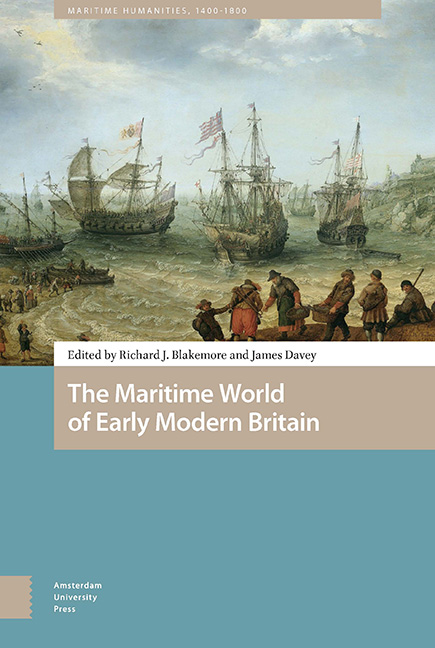Book contents
- Frontmatter
- Contents
- List of illustartions
- Acknowledgements
- Note on Conventions and Terminology
- Introduction
- 1 The Minion and Its Travels: Sailing to Guinea in the Sixteenth Century
- 2 Commanding the World Itself : Sir Walter Ralegh, La Popelinière, and the Huguenot Influence on Early English Sea Power
- 3 An Investigation of the Size and Geographical Distribution of the English, Welsh, and Channel Islands Merchant Fleet: A Case Study of 1571–72
- 4 An Evaluation of Scottish Trade with Iberia during the Anglo-Spanish War, 1585-1604
- 5 Performing ‘Water’ Ralegh : The Cultural Politics of Sea Captains in Late Elizabethan and Jacobean Drama
- 6 ‘Wicked Actions Merit Fearful Judgments’ : Capital Trials aboard the Early East India Company Voyages
- 7 A water bawdy house’: Women and the Navy in the British Civil Wars
- 8 ‘Thy sceptre to a trident change / And straight , unruly seas thou canst command’: Contemporary Representations of King Charles I and the Ship Money Fleets within the Cultural Imagination of Caroline England
- 9 ‘Proud Symbols of the Prospering Rural Seamen’ : Scottish Church Ship Models and the Shipmaster’s Societies of North East Scotland in the Late 17th Century
- 10 Systematizing the Sea : Knowledge, Power and Maritime Sovereignty in Late Seventeenth-Century Science
- Select Bibliography
- About the Contributors
- Index
8 - ‘Thy sceptre to a trident change / And straight , unruly seas thou canst command’: Contemporary Representations of King Charles I and the Ship Money Fleets within the Cultural Imagination of Caroline England
Published online by Cambridge University Press: 21 November 2020
- Frontmatter
- Contents
- List of illustartions
- Acknowledgements
- Note on Conventions and Terminology
- Introduction
- 1 The Minion and Its Travels: Sailing to Guinea in the Sixteenth Century
- 2 Commanding the World Itself : Sir Walter Ralegh, La Popelinière, and the Huguenot Influence on Early English Sea Power
- 3 An Investigation of the Size and Geographical Distribution of the English, Welsh, and Channel Islands Merchant Fleet: A Case Study of 1571–72
- 4 An Evaluation of Scottish Trade with Iberia during the Anglo-Spanish War, 1585-1604
- 5 Performing ‘Water’ Ralegh : The Cultural Politics of Sea Captains in Late Elizabethan and Jacobean Drama
- 6 ‘Wicked Actions Merit Fearful Judgments’ : Capital Trials aboard the Early East India Company Voyages
- 7 A water bawdy house’: Women and the Navy in the British Civil Wars
- 8 ‘Thy sceptre to a trident change / And straight , unruly seas thou canst command’: Contemporary Representations of King Charles I and the Ship Money Fleets within the Cultural Imagination of Caroline England
- 9 ‘Proud Symbols of the Prospering Rural Seamen’ : Scottish Church Ship Models and the Shipmaster’s Societies of North East Scotland in the Late 17th Century
- 10 Systematizing the Sea : Knowledge, Power and Maritime Sovereignty in Late Seventeenth-Century Science
- Select Bibliography
- About the Contributors
- Index
Summary
‘Thy sceptre to a trident change / And straight, unruly seas thou canst command’ is a central image from one of the most opulent court masques of the 1630s, Britannia Triumphans. Performed at Whitehall on Sunday 7 January 1638, Charles I himself took the chief masquing role of Britanocles, the glory of ‘the Westerne World, [who] hath by his wisedome, valour and pietie, not onely vindicated his owne, but farre distant Seas, infested with Pyrats’ (Masque Argument). Devised by Inigo Jones, Surveyor of the King's Works, and William Davenant, Poet Laureate, Britannia Triumphans appears to validate Charles I's well-documented ambition to develop the navy into the most ‘potent’ force ‘for defence, offense, and diversion of any in the Christian world’. As John Taylor, the ‘Water Poet’, so memorably observed, the nation's ships were ‘the impregnable Wooden walls of great Brittaine and Ireland … the winged flying and floating Castles, forts and fortifications for defence against forraigne invasion & domesticall rebellion’. During the 1630s, Charles I made every effort to bolster the navy's ‘floating Castles’, culminating with the Sovereign of the Seas, launched the year before Britannia Triumphans was staged. This flagship was lauded by Thomas Heywood in his True Description of His Majesties Royall and Most Stately Ship as an ‘incomparable structure’ which ‘hath made an inimitable president for all the Kinges and Potentates of the Christian World, or else where’.
Charles's objective was to enhance England's imperial standing and secure the coast from multiple threats of piracy, rapacious Dutch fishing fleets, and the ultimate fear of invasion, embodied by the living memory of the Spanish Armada. Accordingly, as this essay will argue, in the mid-to-late 1630s there was a noticeable focus on the ideal of Charles I as a maritime ruler. This contested ideal permeated through England's wider print and scribal networks, as writers engaged with Charles I's maritime ambitions on both domestic and international fronts, and buoyed the Caroline literary imagination. In particular, Charles I's ship money fleets would become a central image in the furious debates eddying around the increasingly problematic concept of absolute rule.
- Type
- Chapter
- Information
- Maritime World of Early Modern Britain , pp. 193 - 228Publisher: Amsterdam University PressPrint publication year: 2020



